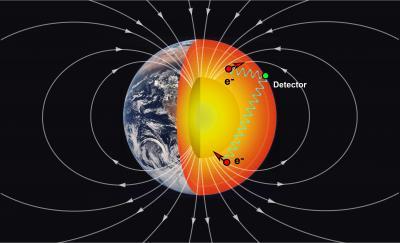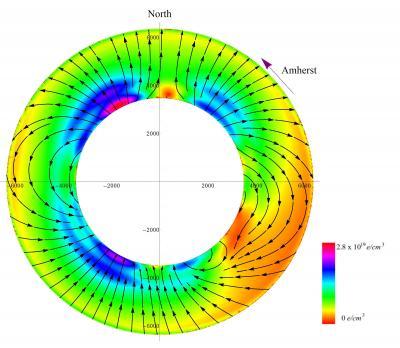Researchers have described a new technique that might one day reveal in higher detail than ever before the composition and characteristics of the deep Earth. There's just one catch: it can't exist.
Instead of being part of the natural world we know, where we have gravity, the weak and strong nuclear forces and electromagnetism the new technique would require a fifth, hypothetical force of nature - a long-range spin-spin interaction. The building blocks of atoms —electrons, protons, and neutrons — separated over vast distances could still "feel" each other's presence.
Earth's mantle is a thick geological layer sandwiched between the thin outer crust and central core, made up mostly of iron-bearing minerals. The atoms in these minerals and the subatomic particles making up the atoms have a property called spin, an arrow that points in a particular direction is a useful metaphor when thinking about spin. It is thought that Earth's magnetic field causes some of the electrons in these mantle minerals to become slightly spin-polarized, meaning the directions in which they spin are no longer completely random, but have some preferred orientation. These electrons have been dubbed geoelectrons.
The goal with the new paper was to discuss if this proposed long-range spin-spin interaction might detect the presence of these distant geoelectrons.
If long-range spin-spin interaction does exist, it would connect matter at Earth's surface with matter hundreds or even thousands of kilometers below, deep in Earth's mantle. In other words, the building blocks of atoms—electrons, protons, and neutrons—separated over vast distances would "feel" each other's presence and the way those particles interact might provide new information about the composition and characteristics of the mantle, which isn't really accessible now.

The picture depicts the long-range spin-spin interaction (blue wavy lines) in which the spin-sensitive detector on Earths surface interacts with geoelectrons (red dots) deep in Earths mantle. The arrows on the geoelectrons indicate their spin orientations, opposite that of Earths magnetic field lines (white arcs). Credit: Marc Airhart (University of Texas at Austin) and Steve Jacobsen (Northwestern University).
New ideas are often generated because the real world is a mystery and this fifth force invocation is no different. When earth scientists try to model how factors such as iron concentration and physical and chemical properties of matter vary with depth — for example, using the way earthquake rumbles travel through the Earth or through laboratory experiments designed to mimic the intense temperatures and pressures of the deep Earth — they obviously get different answers because the models have far too many variables. The fifth force, if it exists, could help make an accurate model.
So the team created a computer model of Earth's interior to map the expected densities and spin directions of geoelectrons, based on laboratory experiments that measure electron spins in minerals at the high temperatures and pressures of Earth's interior. This map provided a basis for guessing the strength and orientations of interactions they might expect to detect in their specific laboratory location in Amherst.
Next, they searched for interactions between geoelectrons deep in the mantle and subatomic particles at Earth's surface. The team's experiments essentially explored whether the spins of electrons, neutrons or protons in various laboratories might have a different energy, depending on the direction with respect to the Earth that they were pointing.

The polarized electron-spin density on a plane that contains Earth's rotation axis and Amherst, Mass., generated by a computer simulation. The black arrows indicate only the direction of the electron spins, while the color shading of the plot indicates the magnitude of the polarized electron spin density. The density of the arrows on the plot is not meaningful. The component of the field into or out of the page is not shown. The electron spin density within the core (white central circle) is assumed to be zero. The violet arrow corresponds to the north orientation and location of the Amherst apparatus. The vertical axis is along Earth's rotation axis, and the axis labels have units of kilometers. Credit: Daniel Ang and Larry Hunter (Amherst College)
"We know, for example, that a magnet has a lower energy when it is oriented parallel to the geomagnetic field and it lines up with this particular direction — that is how a compass works," says Larry Hunter, professor of physics at Amherst College. "Our experiments removed this magnetic interaction and looked to see if there might be some other interaction with our experimental spins. One interpretation of this 'other' interaction is that it could be a long-range interaction between the spins in our apparatus and the electron spins within the Earth, that have been aligned by the geomagnetic field. This is the long-range spin-spin interaction we were looking for."
Their apparatus was not able to detect any such interactions, so they inferred that such interactions, if they exist, must be incredibly weak — no more than a millionth of the strength of the gravitational attraction between the particles. That means they would have to build even more sensitive instruments to search for the elusive fifth force that may not exist - which takes 'sometimes what we don't learn is important' reasoning to a whole new level.
"No one had previously thought about the possible interactions that might occur between the Earth's spin-polarized electrons and precision laboratory spin-measurements," says Hunter.
Citation: Larry Hunter, Joel Gordon, Stephen Peck, Daniel Ang, and Jung-Fu Lin, 'Using the Earth as a Polarized Electron Source to Search for Long-Range Spin-Spin Interactions', Science February 22, 2013: 928-932. DOI:10.1126/science.1227460




Comments